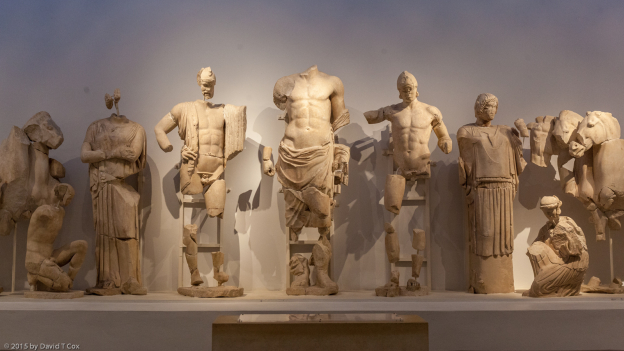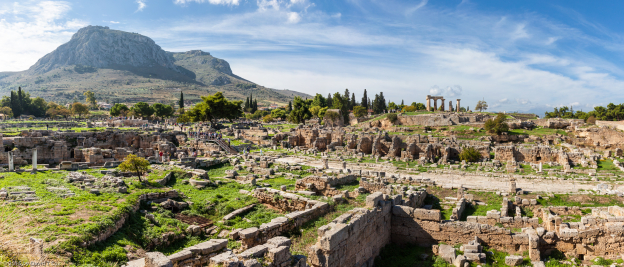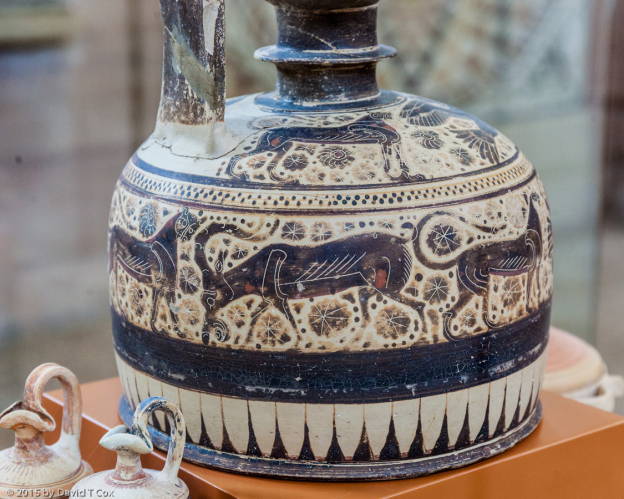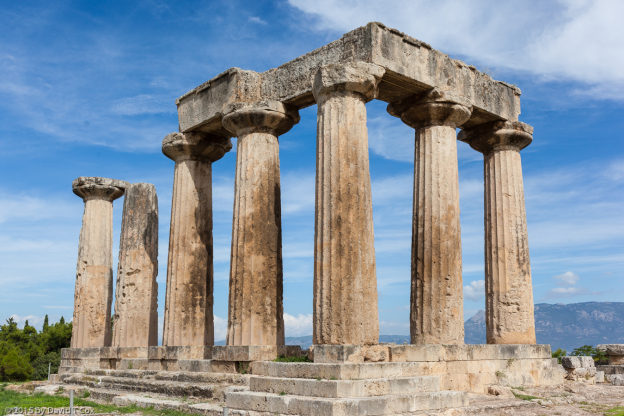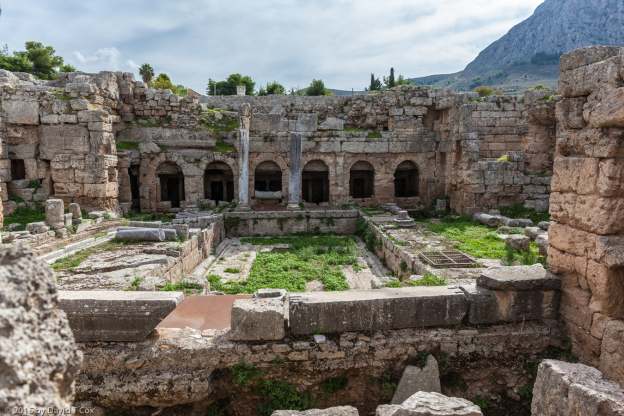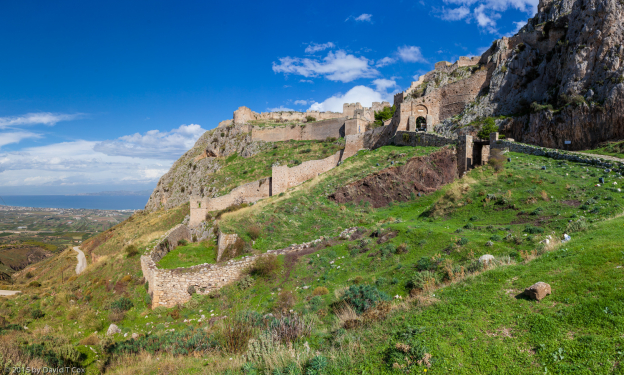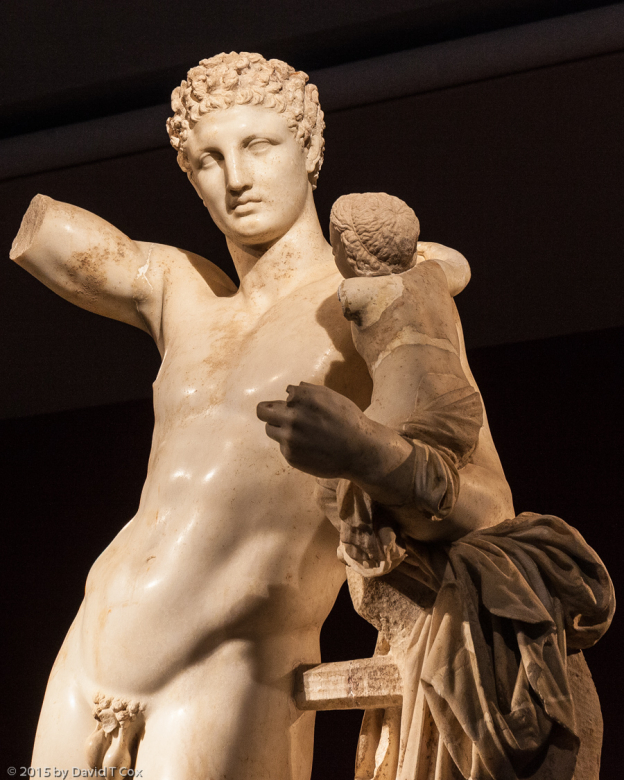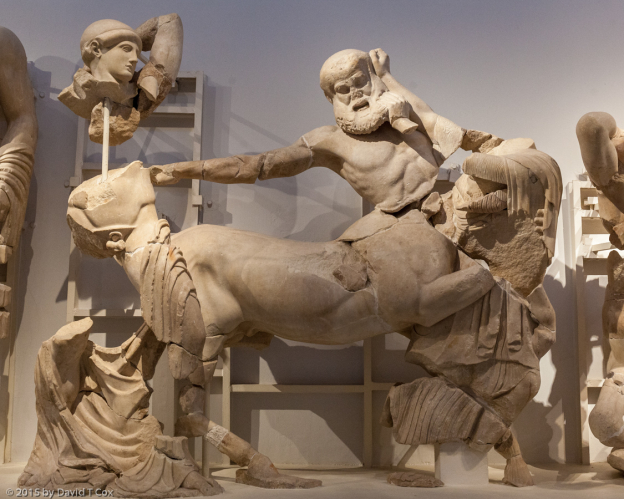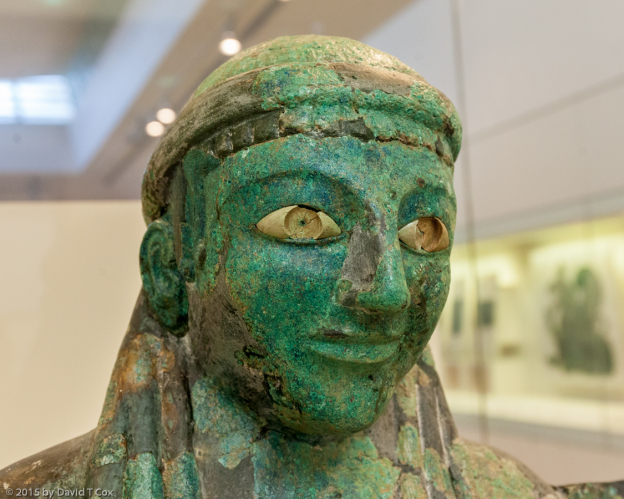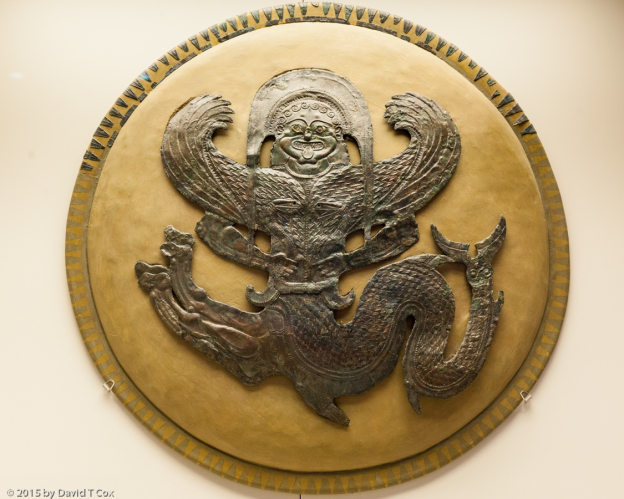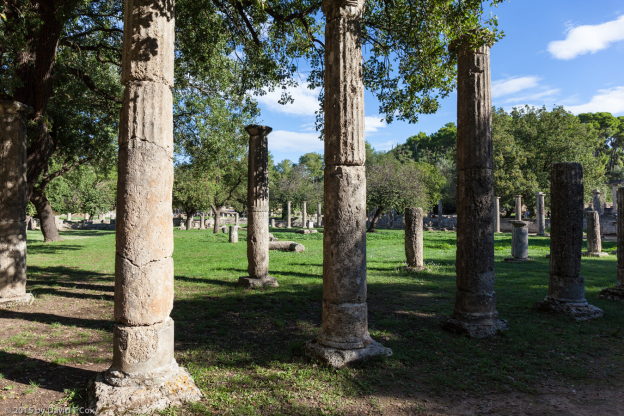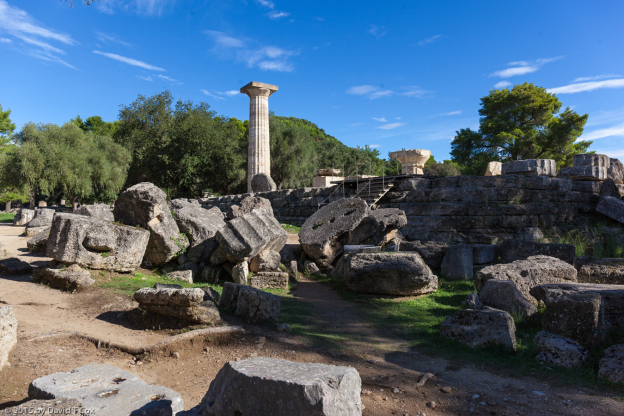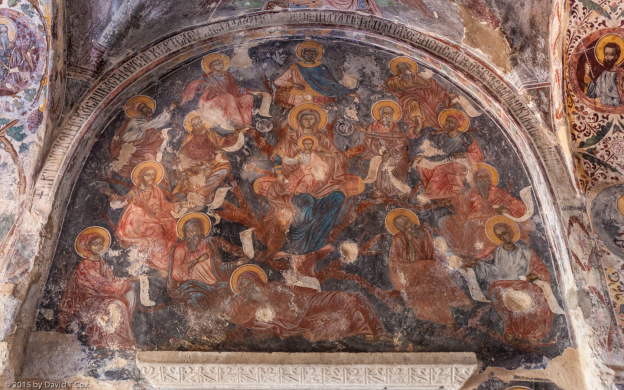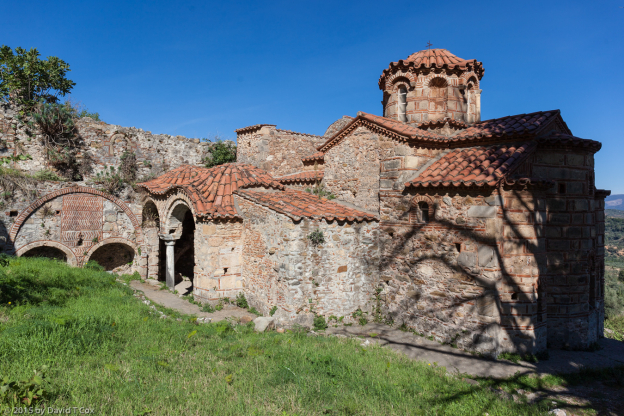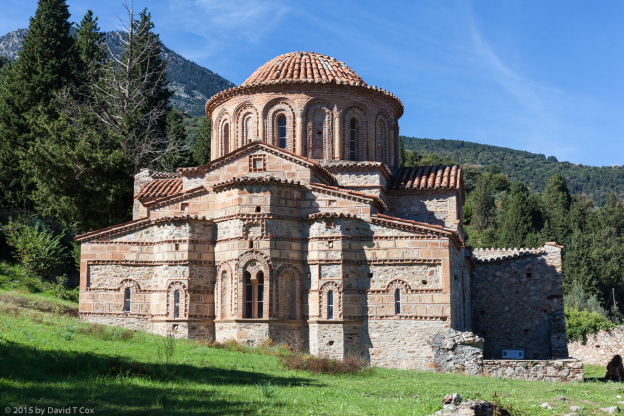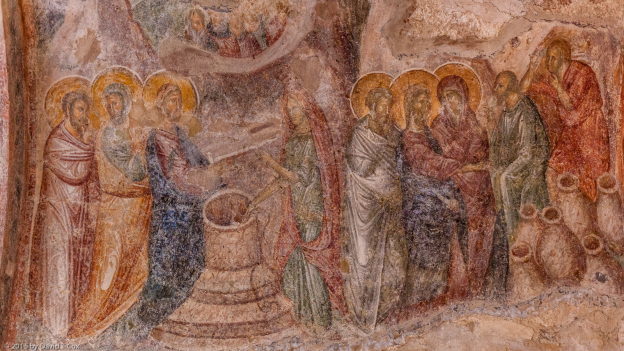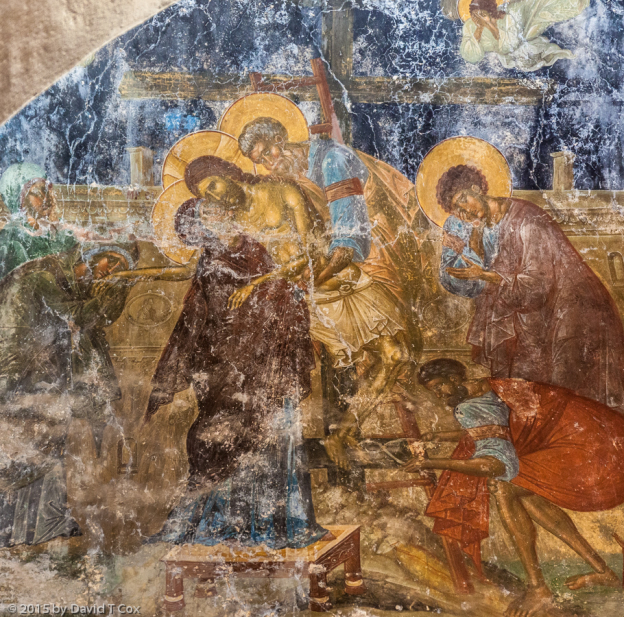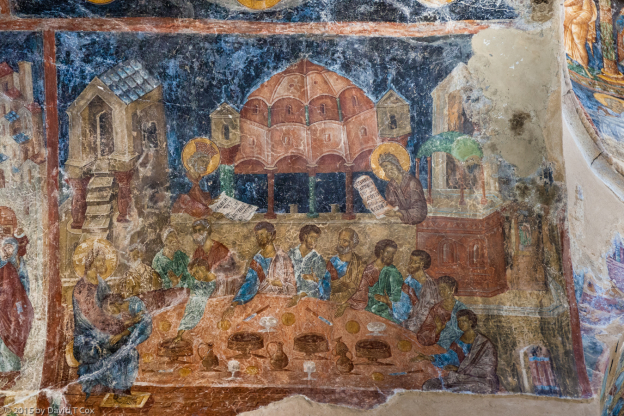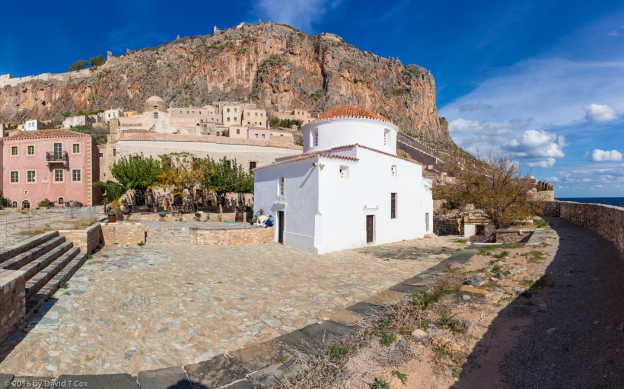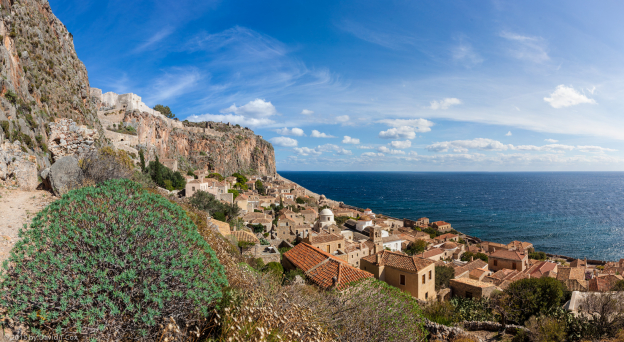All Photos Are Below the Travelogue Text
Click on Any Photo To Open Slide Show
To print the travelogue, right click anywhere on the page. Choose "Print" from your browser dialog box. You can choose Save to PDF in the browser print window.
Share your thoughts.
Email Dave - coxdavid55@hotmail.com
Hello all. I last reported from Athens. On Wednesday over a week ago I traveled by train to the Peloponnese, the large southern dangling section of Greece that just barely is connected at the “Isthmus” to the rest of the landmass. Actually, now, as of the last 122 years, it no longer is connected (except by bridges), as a canal has been built, without locks, across the 6 kilometer neck. The Peloponnese played an outsize role in Greece’s history, producing first the Mycenaean Civilization, and during the later Classic Period producing those great warriors of Sparta and hosting the major original ancient Olympic Games. The Peninsula, on the eastern side, has a greater concentration of ancient ruins than any other part of Greece.
I first stopped in Archaea Korinthos (Ancient Corinth) for a few days. This was one of the oldest continuously occupied cities, from the middle Helladic Period (middle Bronze Age, from 2000 BC), through late Helladic (Mycenaean late Bronze Age), and on through the Greek Dark Ages, the Archaic, Classic, Hellenistic and on into the Roman Period. Here, in the mid-1st century AD, Paul claims to have spent a year and a half attempting to convert the Jews, then the heathens to Christianity, with limited success; however his influence was sufficient to first get him brought before fthe Roman Proconsul on heresy of the faith charges – he was aquited as his teachings were viewed as internal Jewish disagreements. Paul is credited with composing perhaps the greatest Christian letters; those to the Church of Corinth. Today a modern Greek church, standing overlooking the ancient city ruins, has in front a large stone monument engraved with 8 famous verses from Chapter 13 of Paul’s 1st Letter to the Corinthians. After 50 years, I still can almost recite the passage by heart
“If I speak in the tongues of men or of angels, but do not have love, I am only a resounding gong or a clanging cymbal.
If I have the gift of prophecy and can fathom all mysteries and all knowledge, and if I have a faith that can move mountains, but do not have love, I am nothing.”
…………………
Powerful words even for one who no longer believes.
The ruins of Ancient Corinth are very concentrated and compact, and sit on the slopes above the Corinthian Bay to the north, and under the shadow of the 2,000 foot limestone mountain, with shear cliffs, called Akro Korinthos (Acropolis Corinth). The Akro always has served as a fortress, although today the impressive remains are all medieval (mostly Byzantine and Ottoman). The largest structure in Ancient Corinth was the famous Temple to Apollo, which still crowns the highest hill.
From Ancient Corinth I traveled by bus around the northern coast of the Peloponnese, by the city of Patra with its huge suspension bridge over a narrow neck of the Corinthian Bay, to connect the Peloponnese to the mainland of central Greece, and on to Pyrgos. From there a short hop further inland to the ancient site of Olympia, where the original games were produced for almost 1,200 years – makes our 120-or-so-year history of the “modern” games seem rather weak, although with 200 nations now participating, the world coverage is somewhat better than existed in ancient Greece. I think I previously wrote stating that the games at Delphi, called the Pythian Games, were the archaic predecessor of the games at Olympia; this is not true as both started during or before the Archaic Period, although the start date of either is uncertain. During Archaic and Classic Period times, games were organized at both sites along with two other sites (together all called the Panhellenic Games), at 4-year intervals at each site.
The site ruins at Olympia spread over quite a large area, and a confusion of archaic period through late Roman period construction makes the site in some places difficult to understand. Upon entering the site, the first really large structure, with double rows of marble columns on all 4 sides, is the Palestra, the school for wrestling, one of the Olympic sports. The Temple of Zeus is at the heart of the site, along with the older 7th century BC Temple of Hera, for whom earlier games (among women) were established. The Temple of Zeus during the 5th century BC contained a 45 foot chryselephantine statue of Zeus seated (see my prior report for explanation of “Chryselephantine”). Both the Chryselephantine statue of Athena, from the Parthenon (previously reported), and the one of Zeus at Olympia were created by the famous Phidias at his workshop during the 5th century BC. Both were monumental and must have been breathtaking, with the carved ivory skin (Zeus was seated and his entire upper torso, perhaps 10 feet high, was bare, and so covered with ivory, along with his face and hands), the rest covered with gold. The statue of Zeus was one of the seven wonders of the ancient world. Both statues disappeared in the 5th century AD, with independent reports suggesting each was brought to Constantinople, and there lost to mankind.
The Olympia Archeological Site Museum has some wonderful treasures from the ancient sanctuaries. The marble statue of Hermes, photo below, is considered a masterpiece of the Classical Period. Also, the well preserved marble pediments of the Temple of Zeus, especially the Western end showing the battle between the Lapiths and the Centaurs, contains some wonderful marble work.
From Olympia I traveled on Saturday to Sparta, where I stayed in a relatively modern hotel right on the city center. Of Ancient Sparta, very little remains. The ancient theater still sits at the foot of the Acropolis, which contains some ruins of structures. A fair amount of work is ongoing in the area trying to expose and consolidate other ruins, but nothing is labeled. A small museum exists for artifacts found at the Acropolis and nearby Sanctuary of Orthia Artemis, but takes less than half an hour to see everything, and is rather disappointing. Bottom line, Sparta is not worth visiting for Ancient Sparta.
But, 6 kilometers west of Sparta, tumbling down the extremely steep slopes of a rocky mountain at the edge of the Taygetos Range, lies the remains of the medieval Byzantine city of Mystra, and very well worth a visit. At the rocky summit of the mountain sits the ancient fortress, first built by the Franks in the early 13th century, along with that at Monemvasia (my next visit). Within 2 decades Byzantine forces captured the fortresses, and for 2 centuries, as Constantinople declined, Mystra and Monemvasia became the major Byzantine cities in the Greek world. By the mid-14th century, the town of Mystra held 20,000 people, spilling down 900 feet of slopes from the fortress into the “upper” and “lower” cities. By the late 15th century, the town was taken by the Ottoman Turks, and later by the Venetians, before independence in 1821. Today Mystra has been abandoned (except by one small convent of nuns), and the ruins of the city follow the alleys and passages down the mountainside. A number of monasteries and churches remain with magnificent 14th century frescoes covering much of their interiors – I have included photos of 4 of my favorite frescoes, including one unusual view of the Last Supper (over 100 years earlier than Da Vinci’s), and one taking Jesus down from the cross. Mystra now is a World Heritage Site.
From Sparta I traveled yesterday by bus southeast to the coast and the rocky island fortress town of Monemvasia (a sister Byzantine city to Mystra). Monamvasia is a fortress town, like Mystra, which sits on the side and top of a massive rock island which juts almost 2000 feet from the sea, shear cliffs surrounding the upper island, with a low narrow shelf on the south side on which the lower city was built. It served for 200 years as the Byzantine commercial seaport during the 13th and 14th centuries. Unfortunately, the Byzantine ruins of the Upper City are closed (for construction – don’t get me started again). The Lower City has the original alleys and passageways, but is now small hotels and shops for the tourist trade.
I travel next to Nafplio as a center from which to visit half a dozen ancient sites, including Mycenae, finally. Later. Dave
- Ancient Corinth panoramic view looking SW across Lechaion Road (Roman) to Temple of Apollo (Classic Greek 6th C BC), AcroKorinthos Fortifications (Medieval) in distance, Greece
- Corinthian workshop ceramic Oinochoe, from N Cemetery, 6th C BC, Ancient Corinth Site Museum, Greece
- Temple of Apollo, mid-6th C BC, Ancient Corinth, Greece
- Fountain of Peirene, 2nd C BC, Ancient Corinth, Greece
- AcroKorinthos pano 1, medieval fortress above Ancient Corinth, Greece
- statue of Hermes of Praxiteles, considered a masterpiece, Parian marble, Temple of Hermes, 340-330 BC, Olympia Archeological Site Museum, Greece
- Centaur & Lapith woman, West Pediment, Temple of Zeus, Battle between Lapiiths & Centaurs, 470-457 BC, Olympia Archeological Site Museum, Greece
- close up of Lapith Women, West Pediment, Temple of Zeus, Battle between Lapiiths & Centaurs, 470-457 BC, Olympia Archeological Site Museum, Greece
- East Pediment, Temple of Zeus, Chariot Race of Pelops & Oinomaos, 470-457 BC, Olympia Archeological Site Museum, Greece
- Bronze female winged figure, hammered w bone eyes inlaid, one of rarest & valuable example of hammered free-standing works, from Ionian workshop, Bronze offerings of Archaic Period, 590-580 BC, Olympia Archeological Site Museum, Greece
- bronze hammered sheet in shape winged Gorgon w snake girdle, Magna Grecia workshop, 2nd half 8th C BC, Olympia Archeological Site Museum, Greece
- Palestra (wrestling school), Sanctuary of Olympia, Olympia Archeological Site, Greece
- Temple of Zeus, massive fragments of columns in foreground, 470-457 BC, Sanctuary of Olympia, Olympia Archeological Site, Greece
- fresco & carved lintel, Monastery of Pantanassa, 1428, Mystra site, Mystra, Greece
- Evangelistria, Mystra site, Mystra, Greece
- St Theodoroi, Mystra site, Mystra, Greece
- fresco, Hodegetria, Mystra site, Mystra, Greece
- frescoe Removing Jesus from Cross, 14th C, Peribleptos, 1310, Mystra site, Mystra, Greece
- frescoe The Last Supper, 14th C, Peribleptos, 1310, Mystra site, Mystra, Greece
- Panaghia Chrisaffitisa, Monamvasia East Pano 1 , Greece
- Monamvasia from upper trail Pano 1, Greece
To print the travelogue, right click anywhere on the page. Choose "Print" from your browser dialog box. You can choose Save to PDF in the browser print window.
Share your thoughts.
Email Dave - coxdavid55@hotmail.com
